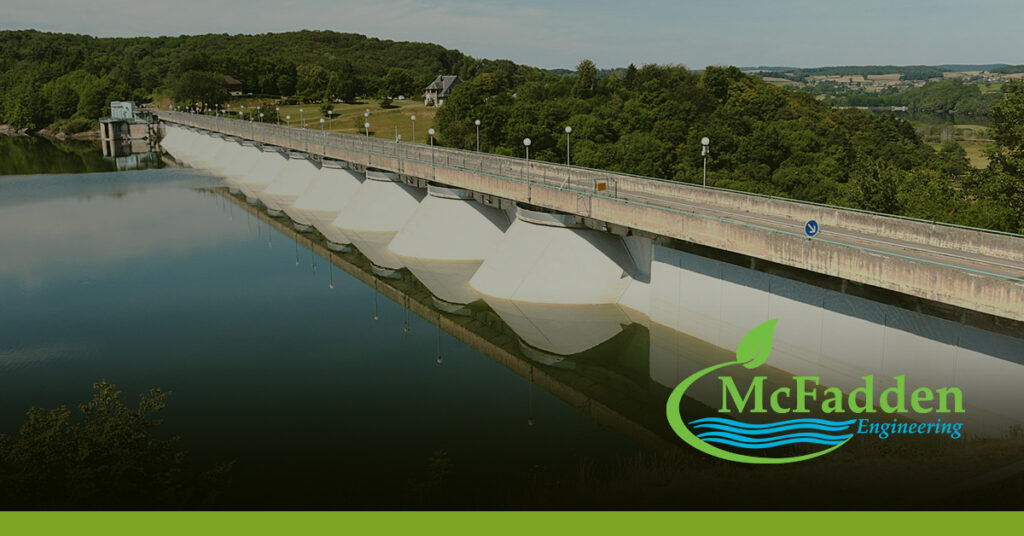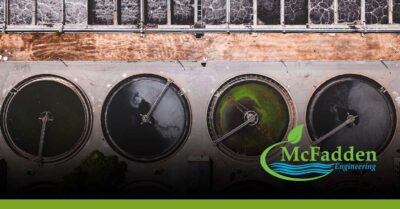McFadden Civil Engineering Services: Detention and Retention Design
August 5, 2022

Determining the difference between detention and retention designs can be tricky. Both detention and retention systems involve methods of controlling flooding and erosion by managing quantities of water. Despite the similarities, the two are very different. In this blog, we discuss our experience with civil engineering services and provide the key differences between detention and retention designs.
Civil Engineering Services at McFadden
Our team at McFadden has a combined 120 years of civil and environmental engineering experience and has been delivering services to commercial and industrial clients in the Southeast for more than 30 years. We provide a broad range of services including master planning, site development, stormwater management and GIS development services. Our goals are to help our clients achieve regulatory compliance, reduce costs, solve complex problems and shrink the environmental footprint for each project we take on.
With a multi-disciplinary approach, we offer services such as development master planning, grading and drainage plan development, stormwater management and detention and retention design. Both detention and retention design are commonly used throughout civil engineering and water management and are even used together on projects like stormwater ponds. It is important to know what detention and retention are to properly determine the service needed.
Detention vs. Retention
Detention
Also referred to as dry ponds, detention ponds mainly offer flood control by controlling the rate of water flow. This is accomplished through a control device typically placed at the entrance to the outlet pipe that maintains the pre-development rate of flow. In both detention and retention design, determining volume of the pond is a key component. Volume refers to the amount of space needed considering the amount of water that the pond will need to hold. To calculate the volume, engineers like our team at McFadden, will compare the pre-development to post-development runoff volumes. The intended goal of a detention pond is to drain water within a certain amount of time to make volume (space) available for the next storm event.
Systems designed with an underdrain or outlet that slowly releases the water downstream are most likely detention systems.
Retention
In contrast to dry detention ponds, retention ponds are referred to as wet ponds. This is because a retention pond permanently holds the water. In some cases, the bottom of the retention pond is placed below the elevation (height) of the groundwater table to create a permanent pool of water.
The amount of water in this pond rises and drops through an outlet source depending on the runoff coming from contributing areas. Both detention and retention ponds are sized based on rainfall runoff and a desired release volume. For a retention pond in particular, the volume of the pond is determined by settling times for target pollutants and evaporation rates for the specific area. In addition, retention ponds allow the vegetation and microbes present to gradually consume nutrients and other pollutants.
Typically, retention ponds are designed to allow time for the sediment to settle to the bottom of the pond prior to the water exiting.
Our team of talented engineers has worked on a variety of projects involving detention and retention design. For example, in 2015 we designed and constructed a new detention pond to capture stormwater runoff from the parking area of Bay City Free Will Baptist Church (BCFWBC) located in Semmes, AL. More recently, McFadden Engineering was retained by Threaded Fasteners (TFI) to provide planning and engineering services for the expansion of its current operation by developing a portion of the 10-acre parcel for the construction of an additional facility for a galvanizing operation. Our team assisted TFI with site design and layout, grading and drainage design, and design of a detention facility that would allow for additional facility expansion. Our work helped ease the growing concerns of church staff and provided the upgrades needed to meet Mobile County, specifications. To learn more about our work with detention and retention designs, complete our contact form or contact us as 251-470-6870.
Related Stories:
Civil Engineering and General Services
Bay City Free Will Baptist Church Parking and Drainage Upgrade
Interested in learning about other services?
At McFadden, we use a holistic approach to provide a variety of engineering services that aim to meet the unique needs of our clients.
